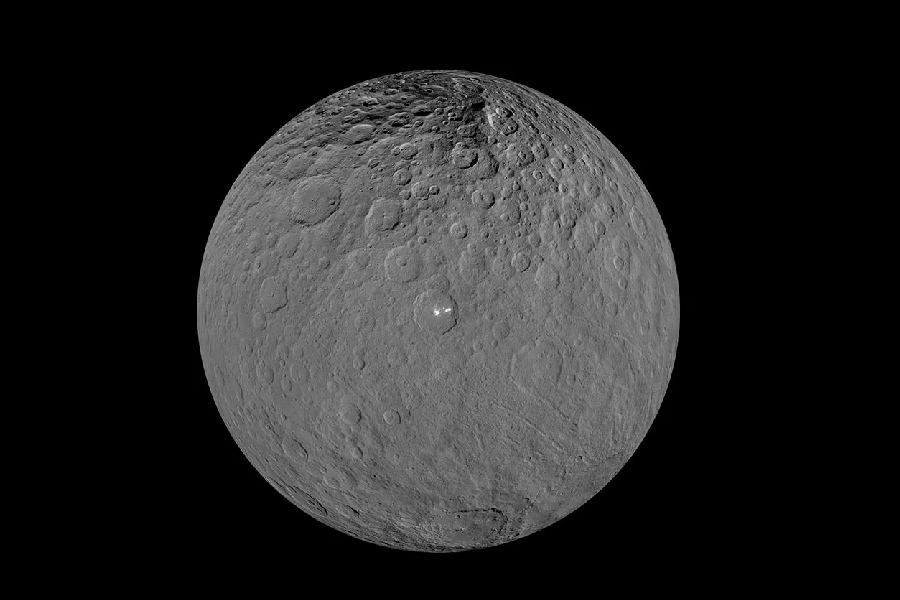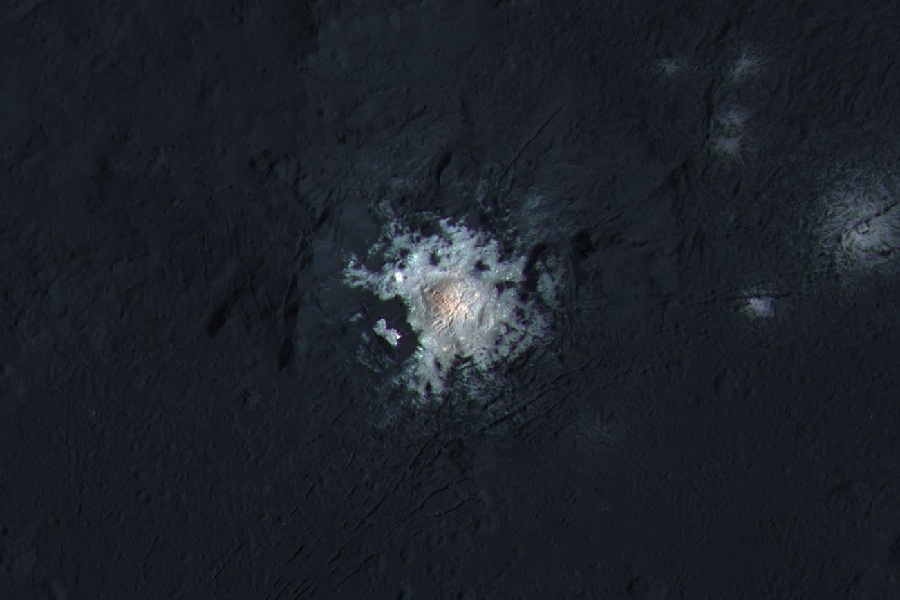The largest object in the asteroid belt between Mars and Jupiter, Ceres has captivated astronomers since its discovery over two centuries ago. Though officially classified as an asteroid, it stands out from its rocky neighbors in many regards, and that’s why we’ll focus on some facts about Ceres in this article.
Its substantial size and mass, approaching almost a quarter of our moon’s, seem to set it apart from typical asteroids. And its surface displays signs of fascinating complexity, unlike the airless rubble piles that surround it.
But with the recent arrival of orbiting spacecraft, our knowledge of Ceres has accelerated rapidly. New observations peer beneath its cratered face and into its hidden interior more than ever before.
What astounding facts have we uncovered about this small world that blurs the line between asteroid and planet? Ceres continues to unveil surprises – from the nature of its composition and activity to the mysteries of its formation and evolution over eons.
Read on to explore some intriguing facts about Ceres that still have scientists striving to completely characterize this diminutive yet dynamic denizen of the inner Solar System.

9 Facts About Ceres
What are some fun facts about Ceres? Ceres is a dwarf planet located in the asteroid belt between Mars and Jupiter. It is the largest object in the asteroid belt and was the first dwarf planet to be visited by a spacecraft, NASA’s Dawn mission.
Ceres is approximately 590 miles (940 kilometers) in diameter and is composed mainly of water, ice, and rock. It has a unique bright spot on its surface.
Believed to be a deposit of reflective salts. Ceres is of particular interest to scientists studying the early Solar System and planetary formation.
Ceres is named after the Roman goddess of agriculture
Ceres was discovered in 1801 by Giuseppe Piazzi. He named it after the Roman goddess of agriculture. Ceres was the goddess of the harvest and fertility in mythology. The name signifies the dwarf planet’s ability to support life, as Piazzi suspected.
Early observers thought they saw vegetation on Ceres. But that turned out to be false. Still, the name Ceres stuck even after its status as an asteroid was realized.
It’s known as the first asteroid to be discovered
The discovery of Ceres carries major historical weight in astronomy. It was the very first asteroid ever found. Located between Mars and Jupiter, Ceres led to the realization that many more small objects existed there.
An entirely new class of minor planets had been uncovered. The discovery of Ceres kickstarter asteroid hunting and the revelation that planets had failed to form in the asteroid belt region. It contributed greatly to understanding the Solar System’s true contents and origins.
Ceres has a spherical shape and may have an atmosphere
Ceres has a rounded, spherical shape that sets it apart from unevenly shaped asteroids. Gravity has pulled Ceres into a ball as its mass is large enough. Some models indicate Ceres may have a thin, transient atmosphere.
Its icy surface could emit vapor when struck by charged particles from the Sun. But an atmosphere has not been directly detected yet. Further study is needed to confirm if Ceres has any atmosphere at all.
It’s the largest object in the asteroid belt
Early telescope observations underestimated Ceres’ size. It was assumed to have half its true diameter. NASA’s Dawn spacecraft mapped Ceres in detail from orbit starting in 2015. Dawn revealed Ceres spans almost 621 miles across.
This makes it by far the largest object in the entire asteroid belt. No other asteroid comes close to matching its substantial proportions relative to the rest.
Ceres is 25% less dense than water
Despite being the largest asteroid, Ceres has surprisingly low gravity due to its density. Researchers expected higher gravity based on Ceres’ size. But orbiting probes revealed Ceres has only 2.8% of Earth’s gravitational pull.
This indicates Ceres is 25% less dense than water, making it very porous inside. The core is loosely packed for reasons unknown.
Ceres has several mysterious bright spots
The puzzling enigma – Shining beacons on a dwarf planet
Strangely bright spots stand out on Ceres’ surface, visible to space telescopes. The largest bright area lies inside the Occator crater. What makes these spots so reflective is a deep mystery astronomers struggle to explain.
No other asteroids display such odd, highly reflective markers. The spots appear too transient for ice yet remain bright over the years.
Debunking theories – Scientists grappling with unexplained illumination
Researchers proposed many theories on the strange bright spots. Frozen water was a prime suspect. But ice would vanish rapidly when exposed on Ceres’ warm surface.
Some conjectured sodium carbonate or salt deposits might be responsible, yet proof is lacking. No explanation fully accounts for the spots’ reflectivity and persistence.

Ceres’ brighter crater is Occator
Occator’s ongoing riddle – Bright spot central
The most intense bright feature glistens from the Occator crater. This 57 miles wide crater harbors the most substantial bright spot by far. Multiple reflective areas concentrate in the Occator’s center. What makes this unassuming crater so bright remains unknown.
Occator hides signatures from Ceres’ interior struck during its formation. But the secrets of its gleaming floors keep astronomers guessing.
Speculation and hypotheses – Ice volcanoes or alien signals?
Experts theorize evaporating subsurface ice or salty flows is called cryovolcanism. However, the phenomena do not completely match observations.
Joking suggestions of giant mirrors or even alien cities fail to satisfy serious scrutiny as well. Occator’s glimmering patches continue to confound the explanation. More research is clearly needed.
Ceres’ elusive ocean may lie 15-24 miles below planet’s surface
Hidden depths – Whisperings of a subterranean sea
Gravity data from the Dawn mission hints at a global ocean under Ceres’ crust. A subsurface sea could explain the density deficit and other observations. The ocean would lie 15-24 miles below Ceres’ surface based on models. It may contain as much water as Earth’s sea. However, more data is needed to verify its existence.
Probing the depths – Challenges in confirming Ceres’ watery secrets
Confirming Ceres’ ocean is extremely difficult with current tools. No direct measurements have penetrated to such depths within Ceres yet. Gravity clues remain ambiguous and depend heavily on interpretation.
Future landers with seismometers could better detect an ocean’s presence through the dwarf planet’s response to meteor strikes. For now, the hidden sea remains hypothetical and a profound target for future exploration.
Dawn mission around Ceres lasted around 3.5 years
Dawn’s journey – Unveiling Ceres’ quirks
NASA’s Dawn spacecraft entered orbit around Ceres in March 2015 after leaving Vesta. Dawn spent around 3.5 years mapping Ceres’ landforms, interior structure, and composition from four science orbits. The probe imaged the entire surface in vivid detail, revealing much about this little-understood world before its demise.
Unexpected discoveries – Dawn’s findings that baffled scientists
Dawn exposed many unexpected aspects of Ceres that puzzle researchers. It found ultra-bright salty spots with unclear sources. A lonely mountain peak towers mysteriously over the landscape. And a potential subsurface ocean comes without definitive confirming clues.
More study is needed to unravel the new insights Dawn provided into one of the Solar System’s most bizarre asteroids.
Conclusion
As the largest denizen of the asteroid belt, the dwarf planet Ceres continues to unveil astonishing characteristics the more we explore it. From its spherical shape and bewilderingly bright spots to hints of a hidden subsurface ocean.
This small world challenges notions of what an asteroid should be. Ceres stands uniquely on the threshold between asteroid and planet, bearing signs of geologic activity and an active evolution over billions of years.
We hope this glimpse into some intriguing facts about Ceres has brought greater appreciation for this complex mini-world that defies simple categorization.
Ceres beckons as an ocean world in space, a harborer of ancient water, and a survivor boasting secrets from across the Solar System’s history. The more we uncover, the more Ceres astonishes as an asteroid like no other known, shining ever brighter with potential insights and discoveries.
